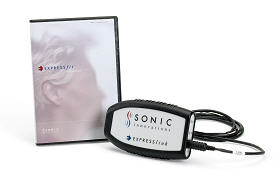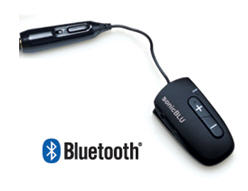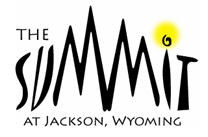Interview with Michael Nilsson, Vice President of Auditory Research, Sonic Innovations
Topic: The Velocity Product Family - Velocity 4, 6, 12 and 24

CAROLYN SMAKA: Today I'm speaking with Dr. Michael Nilsson from Sonic Innovations. Michael, welcome back to AudiologyOnline.
MICHAEL NILSSON: Thank you very much.
SMAKA: Today we're talking about the Velocity product family that has expanded this year.
NILSSON: Yes. With this Velocity product family, it's the first time we're offering a complete product family under one brand name. In the Velocity family we have four different technology tiers - entry level, premium and two levels in between. Rather than have professionals trying to remember, "Well, what was the name of that mid priced level product? What were the differentiating features from the other products?", we've tried to make it easy to understand and to create clear differentiation with a complete product line under one family name.
SMAKA: The first thing that comes to mind when I hear you say that is it must make hearing aid selection and counseling so much easier.
NILSSON: Yes. That's one thing that has driven us to try this and we've seen some other manufacturers do similar things. In Australia, we have a large subsidiary that owns retail shops. They've given us a lot of input on not only how to improve the technology, but also how to make it easy for the end user to understand the differences between an entry level product, a mid tier, a top tier, and so forth. All of this great information has influenced how we design and create product families.
SMAKA: Are the Velocity marketing materials integrated as well?
NILSSON: Yes, the literature actually shows all four tiers of the Velocity family in one brochure. So it's very easy to understand what the differences are, and what you get if you are going to move up a level in technology. It will also give professionals clear ideas of what type of patient is appropriate for what level, to help guide with hearing aid selection.
SMAKA: The Velocity product family consists of what models?

NILSSON: We have a complete line of custom products from CIC up to Power ITE. There is a standard BTE available in all product lines. We also have a small BTE in our entry level right now that is available as an open product. In the higher tiers, it's an even smaller convertible miniBTE - slim tube or earhook.
SMAKA: You mentioned that with the multitier Velocity product family it's easy to differentiate between levels. What drives the differentiation between the technology tiers within this family?
NILSSON: We have four different tiers. The entry level is Velocity 4, then you move up to Velocity 6, then 12, then 24. The numbers refer to the compression channels and the programming handles. So in Velocity 4, it's very basic as you'd expect from an entry level product. There are four compression regions across the frequency range, and you have four handles to control those four compression regions. Velocity 4 gives you a very fast fitting, but it doesn't give you a lot of fine tuning detail for someone with a complex loss.
With Velocity 6, there are six compression regions and six programming handles. So the professional has a little bit more control and a slightly broader frequency response.
With Velocity 12 and Velocity 24, there are nine programming handles that are the traditional format used with previous Sonic Innovations products. In Velocity 12, there are 12 compression regions and with Velocity 24, there are 24 compression regions. So the compression regions and number of programming handles help to differentiate, and as you move up in technology tier, you'll also see more nice-to-have features.
For example, Velocity 24 has voice alerts. In the software, the professional can select either a male or female voice in one of about 12 different languages. The voice will actually tell the patient which program they're switching into for manual program changes. It will also tell the patient when the battery is low. It's not necessary, and it doesn't really improve performance unless it helps the patient choose the correct program, but it is a nice reminder. People don't have to learn what was in program two versus three, for example. Voice alerts are only available in Velocity 24. It's one of those nice-to-have features that differentiates Velocity 24 from Velocity 12 and the other tiers.
SMAKA: Velocity 6 is the newest addition, correct?
NILSSON: That's correct. At first we introduced Velocity 4, 12 and 24. We've just recently released Velocity 6, and a lot of people are really excited about that. Although Velocity 4 is a great entry level product, it's very basic and some professionals told us they'd rather start the patient off with a product that had a few more features and one that they had a bit more control over. So Velocity 6 became the new entry level product for some professionals.
SMAKA: Do you have the same wonderful Sonic Innovations software to fit these products?

NILSSON: Yes, it's still our intuitive, easy-to-use, fitting software, EXPRESSfit. Version 5.9 is used to fit the entire Velocity family. It's graphically based, so it's just like working on a graphic equalizer. We have two curves that can be manipulated directly on the screen, one for 50 dB inputs and one for 90 dB inputs. For some people, it's helpful to think of the 50 as the gain curve and the 90 as the output curve. Other people think of it as soft and loud.
SMAKA: What have you heard from people wearing Velocity?
NILSSON: At Sonic Innovations headquarters here in Salt Lake, we're all in one building. I'm in auditory research, and the lab where we actually do subject testing is on the first floor. Our marketing department is up on the sixth floor. Whenever we come out with a new product, the marketing group tries to find any of the volunteers that have been testing the product, and see if they are willing to talk about their experiences. We have one woman that was fit with Velocity 12 and her story is particularly touching.
She is a young mother with a serious hearing loss. She's had it for quite a while, and her big concern is being able to hear her children if they start crying in the house. If her hearing aids aren't working well, her children may get injured or call out to her, and she won't know anything about it because she can't hear them when they are in different rooms of her home.
She stated that since she's been fit with Velocity 12, it's the first time in her life where she can finally relax in her own home. With Velocity 12, she doesn't worry about her children as much because she's confident that she could hear them should they ever call out. She is included in a short video of consumer testimonials about the Velocity line available to customers, which is another nice addition to the product offering.
SMAKA: What a difference in quality of life. At the end of the day, it's why most of us went into audiology in the first place.
NILSSON: Exactly. It's those kinds of anecdotal stories that we really live for. When someone comes in and tells us how life changing their experience has been with our products it makes it all worthwhile.

SonicBLU
SMAKA: To switch gears, I wanted to ask you about sonicBLU. Are all the Velocity models with telecoils compatible with sonicBLU?
NILSSON: Yes. The interesting thing about sonicBLU is that it is a relatively inexpensive and simple to use Bluetooth transducer. People just want to use their cell phones without problems. You don't need a hugely complex, intricate solution. With sonicBLU, you wear it either around your neck, or using an earhook to allow a stronger signal to your hearing aid. It's a fairly simple device, and it enables you to connect to any Bluetooth compatible phone without having to pick up the phone and figure out, where do I place the phone on the ear? And we have had a tremendously positive response to sonicBLU. And it works with any product with a telecoil, including any of the Velocity family of products with telecoils.
SMAKA: Michael, I heard about a pretty cool conference that you're organizing, can we talk about that?
NILSSON: Sure. I'm organizing and chairing a revival of the conference in Jackson at the Jackson Lake Lodge. It will take place the first week in September of this year, at the same time of year as the original Jackson Hole conference. We have a full plate of presenters lined up. The conference will start with a Thursday evening dinner, and there will be presentations Friday, Saturday, and Sunday. And then people can travel home or stay for a little extra vacation on Monday, which is Labor Day.
The weather is typically spectacular in Jackson, Wyoming at that time of year. The hotel is considered an historic landmark at the base of the Teton Mountains, so it's a fantastic location. It was originally built by the Rockefellers, who were mainly responsible for preserving the land around the Tetons from development and keeping the park there.
The conference theme is "What Is Old Is New Again," because I keep running into these ideas in our industry that people have and say, "Wow, what a great idea! Why hasn't anyone thought of that before?" And then you run into other people that say, "Yeah, I remember when that was out about 25 years ago."

SMAKA: [laughs]
NILSSON: Somebody had an idea and tried it, but it just didn't work well, or the technology wasn't up to date. So the theme of the conference and the guiding influence to the presentations is "What Is Old Is New Again." It is an open conference and we have sponsors from all around the world including Australia, the US, and Europe. It's not a marketing conference for any particular company. More information can be found at www.summitatjackson.com. Another great thing about the conference is that two different journals are interested in publishing the presentations. So our plan is that the proceedings from the conference, which won't fit in one journal, will be published after the conference.
SMAKA: It sounds awesome! I'm wondering if you would do me a favor after this interview wraps up, and make a phone call to Paul Dybala, my boss, and ask him if I can go to that conference. [laughs]
NILSSON: Sure, OK! [laughs]
SMAKA: Thanks! I love that theme "What Is Old Is New Again". So many developments come to mind - data logging, nonlinear frequency compression, for instance. Some of us are like, "wow' and others are like, "I remember that from way back".
NILSSON: Exactly. It's all been tried before, and for some reason or other it wasn't hugely successful at the time. And now it's back in a new implementation and everybody thinks, "Wow, this is such a great new idea." And it's not that new of an idea.
SMAKA: Another thing I wanted to mention is congratulations on the one millionth instrument!
NILSSON: Well, thank you very much. It's pretty exciting to think how quickly the ten years have gone by and that we've already hit our one millionth instrument. And what's interesting is that every now and then I'll still hear someone say, "Sonic! Oh, who knows if they're going to be around very long?"
SMAKA: [laughing] Oh, that's funny! Let's mention that in our interview after the two millionth instrument.
Michael, I really appreciate your speaking with me today. I know this is a busy time of year so thank you for making the time for this interview. It was great speaking with you and I hope we can do it again soon.
NILSSON: Yes, I hope so, too. We've got plans for lots of new, exciting things in 2009. Thanks, Carolyn.
More information about the Velocity product family and Sonic Innovations other solutions can be found at www.sonici.com or at Sonic Innovations Web channel on AudiologyOnline, www.audiologyonline.com/channels/sonic_innovations.asp
